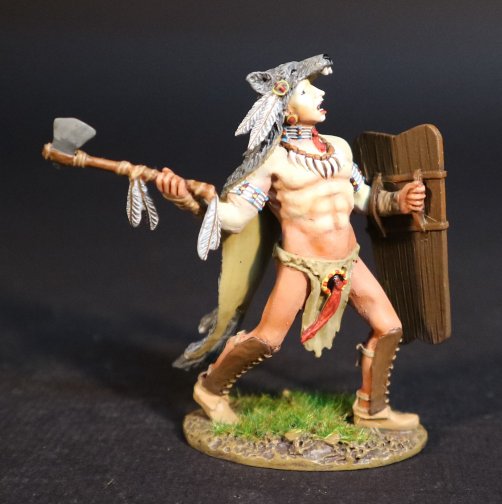- Joined
- Feb 2, 2011
- Messages
- 2,348
NEW RELEASES FOR DECEMBER 2023
THE AGE OF ARTHUR
THE BATTLE OF HASTINGS 1066
THE NORMAN ARMY
The Battle of Hastings took place on the 14[SUP]th[/SUP] October 1066. Although the numbers on each side were about equal, William had the advantage of having both cavalry, infantry and many archers.
Harold had only foot soldiers, and few archers. The English formed a shield wall along a ridge, and were initially so effective that the invading Norman army was repeatedly thrown back with heavy casualties.
BISHOP ODO OF BAYEUX
Odo was the son of William the Conqueror’s mother Herleva and Herluin de Conteville. There is uncertainty about his birth date, and it is believed he was born around 1035. Duke William made him bishop of Bayeux in 1049.
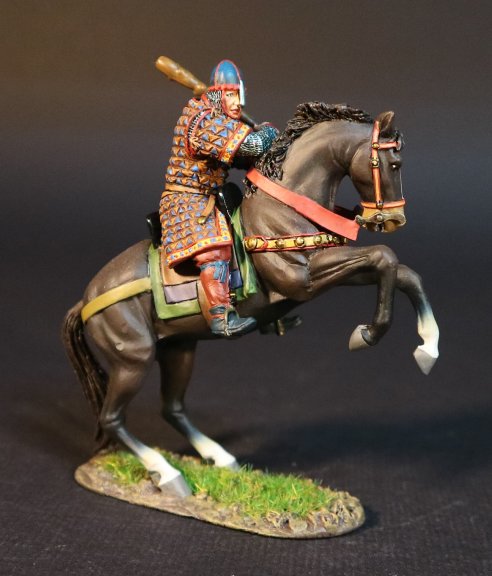
NM-12
THE AGE OF ARTHUR,
THE NORMAN ARMY,
BISHOP ODO OF BAYEUX.
Although Odo was an ordained Christian cleric, he is best known as a warrior and statesman. He funded ships for the Norman invasion of England and is one of the very few proven companions of William the Conqueror known to have fought at the Battle of Hastings in 1066.
The Bayeux Tapestry which was probably commissioned by him to adorn his own cathedral, appears to make the point that he did not actually fight, that is to say shed blood, but rather encouraged the troops from the rear.
The Latin annotation embroidered onto the Tapestry above his image reads, “Hic Odo Eps Baculu Tenens Conortat Pueros”, “Here Odo the Bishop holding a club strengthens the boys”.
It has been suggested that his clerical status forbade him from using a sword, although this is doubtful. The club was a common weapon and used often by leaders including the Duke William himself, as also depicted in the same part of the Tapestry.
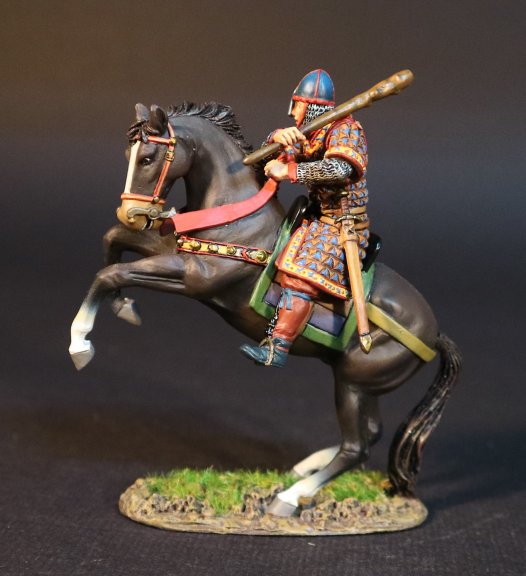
In 1067, Odo became Earl of Kent, and for some years he was a trusted royal minister. On some occasions when William was absent (back in Normandy) he served as regent of England, and at times he led the royal forces against rebellions (eg, the Revolt of the Earls).
During this time, Odo acquired vast estates in England, larger in extent than anyone except the king. He had land in twenty three counties, primarily in the south east and in East Anglia.
THE VIKINGS
VIKING ARCHERS
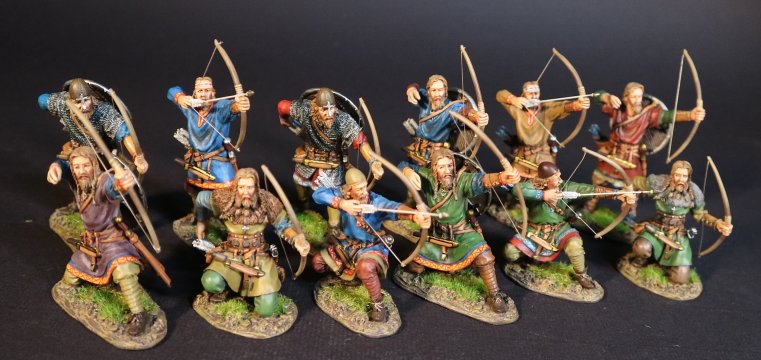
The Vikings made considerable use of the bow, both on land and at sea. Not only was it used to a considerable extent by the bondi (in Norway and Sweden the word “bow” could even be used to mean a warrior) but also it was used by nobles and kings, who took great pride in their personal accuracy.
Viking bows were mainly made from elm, although yew was also used.
In the Leidang bows were provided as part of the ship’s equipment. It was known that a bow and 24 arrows were supplied per 2 oarsmen. This suggests that up to 50per cent of a Viking national army might in fact be bow armed.
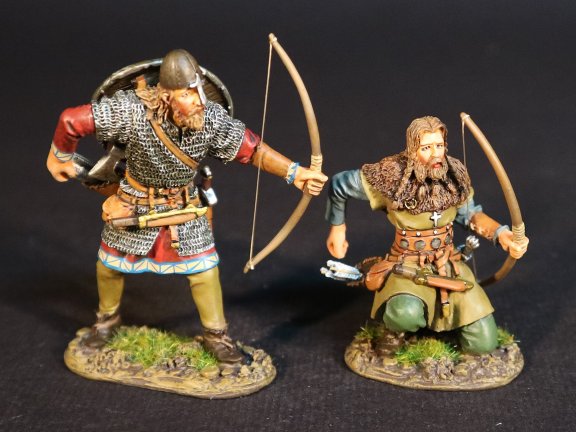
VIK-40A
THE AGE OF ARTHUR,
THE VIKINGS,
VIKING ARCHERS.
(2 pcs)

VIK-40B
THE AGE OF ARTHUR,
THE VIKINGS,
VIKING ARCHERS.
(2 pcs)

VIK-40N
THE AGE OF ARTHUR,
THE VIKINGS,
VIKING ARCHERS.
(4 pcs)
THE GREAT SIEGE OF MALTA 1565
The Great Siege of Malta occurred in 1565 when the Ottoman Empire attempted to conquer the Island of Malta, then held by the Knights Hospitaller.
The siege lasted nearly four months, from 18[SUP]th[/SUP] May to 11[SUP]th[/SUP] September 1565.
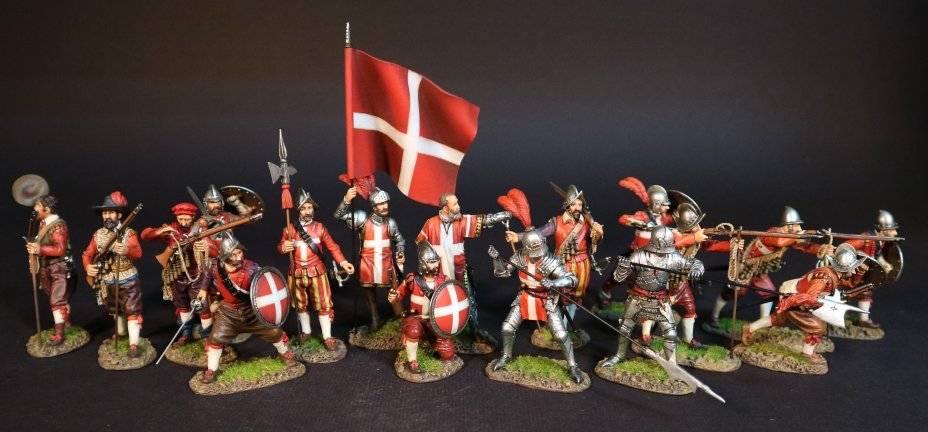
The Knights Hospitaller had been headquartered in Malta since 1530, after being driven out of Rhodes, also by the Ottomans, in 1522, following the Siege of Rhodes.
The Ottomans first attempted to take Malta in 1551 but failed. In 1565, Suleiman The Magnificent, the Ottoman Sultan, made a second attempt to take Malta.
The Knights, who numbered around 500 together with approximately 6,000 foot soldiers, withstood the siege and repelled the invaders. This victory became one of the most celebrated events of Sixteenth Century Europe, to the point that Voltaire said,
“Nothing is better known than the Siege of Malta”.
It undoubtedly contributed to the eventual erosion of the European perception of Ottoman invincibility, although the Mediterranean continued to be contested between Christian coalitions and the Muslim Turks for many years.

MALT-10
THE CRUSADES,
THE GREAT SIEGE OF MALTA 1565,
KNIGHTS OF THE ORDER OF ST.JOHN OF JERUSALEM,
KNIGHT.
(2 pcs)
THE AGE OF ARTHUR
THE BATTLE OF HASTINGS 1066
THE NORMAN ARMY
The Battle of Hastings took place on the 14[SUP]th[/SUP] October 1066. Although the numbers on each side were about equal, William had the advantage of having both cavalry, infantry and many archers.
Harold had only foot soldiers, and few archers. The English formed a shield wall along a ridge, and were initially so effective that the invading Norman army was repeatedly thrown back with heavy casualties.
BISHOP ODO OF BAYEUX
Odo was the son of William the Conqueror’s mother Herleva and Herluin de Conteville. There is uncertainty about his birth date, and it is believed he was born around 1035. Duke William made him bishop of Bayeux in 1049.

NM-12
THE AGE OF ARTHUR,
THE NORMAN ARMY,
BISHOP ODO OF BAYEUX.
Although Odo was an ordained Christian cleric, he is best known as a warrior and statesman. He funded ships for the Norman invasion of England and is one of the very few proven companions of William the Conqueror known to have fought at the Battle of Hastings in 1066.
The Bayeux Tapestry which was probably commissioned by him to adorn his own cathedral, appears to make the point that he did not actually fight, that is to say shed blood, but rather encouraged the troops from the rear.
The Latin annotation embroidered onto the Tapestry above his image reads, “Hic Odo Eps Baculu Tenens Conortat Pueros”, “Here Odo the Bishop holding a club strengthens the boys”.
It has been suggested that his clerical status forbade him from using a sword, although this is doubtful. The club was a common weapon and used often by leaders including the Duke William himself, as also depicted in the same part of the Tapestry.

In 1067, Odo became Earl of Kent, and for some years he was a trusted royal minister. On some occasions when William was absent (back in Normandy) he served as regent of England, and at times he led the royal forces against rebellions (eg, the Revolt of the Earls).
During this time, Odo acquired vast estates in England, larger in extent than anyone except the king. He had land in twenty three counties, primarily in the south east and in East Anglia.
THE VIKINGS
VIKING ARCHERS

The Vikings made considerable use of the bow, both on land and at sea. Not only was it used to a considerable extent by the bondi (in Norway and Sweden the word “bow” could even be used to mean a warrior) but also it was used by nobles and kings, who took great pride in their personal accuracy.
Viking bows were mainly made from elm, although yew was also used.
In the Leidang bows were provided as part of the ship’s equipment. It was known that a bow and 24 arrows were supplied per 2 oarsmen. This suggests that up to 50per cent of a Viking national army might in fact be bow armed.

VIK-40A
THE AGE OF ARTHUR,
THE VIKINGS,
VIKING ARCHERS.
(2 pcs)

VIK-40B
THE AGE OF ARTHUR,
THE VIKINGS,
VIKING ARCHERS.
(2 pcs)

VIK-40N
THE AGE OF ARTHUR,
THE VIKINGS,
VIKING ARCHERS.
(4 pcs)
THE GREAT SIEGE OF MALTA 1565
The Great Siege of Malta occurred in 1565 when the Ottoman Empire attempted to conquer the Island of Malta, then held by the Knights Hospitaller.
The siege lasted nearly four months, from 18[SUP]th[/SUP] May to 11[SUP]th[/SUP] September 1565.

The Knights Hospitaller had been headquartered in Malta since 1530, after being driven out of Rhodes, also by the Ottomans, in 1522, following the Siege of Rhodes.
The Ottomans first attempted to take Malta in 1551 but failed. In 1565, Suleiman The Magnificent, the Ottoman Sultan, made a second attempt to take Malta.
The Knights, who numbered around 500 together with approximately 6,000 foot soldiers, withstood the siege and repelled the invaders. This victory became one of the most celebrated events of Sixteenth Century Europe, to the point that Voltaire said,
“Nothing is better known than the Siege of Malta”.
It undoubtedly contributed to the eventual erosion of the European perception of Ottoman invincibility, although the Mediterranean continued to be contested between Christian coalitions and the Muslim Turks for many years.

MALT-10
THE CRUSADES,
THE GREAT SIEGE OF MALTA 1565,
KNIGHTS OF THE ORDER OF ST.JOHN OF JERUSALEM,
KNIGHT.
(2 pcs)



